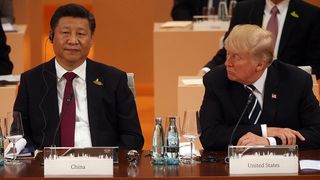Aside from reiterating his commitment to key Asian allies, President Trump's main mission during his visit this week is to drum-up support for “maximum pressure” tactics on North Korea and place his “reciprocal trade” agenda at the heart of bilateral relations with Japan, South Korea, and China. The former aligns with the aims of America’s partners, though only if preventative military options are shelved. The latter creates a degree of political friction at a time when strategic coordination between like-minded nations is the more important priority.
What Trump isn’t doing – as I explain here – is turning up with a clearly articulated regional strategy that would replace the Obama administration’s “pivot to Asia”. This is what anxious regional partners are looking for to regain their confidence in Washington’s staying power. In addition to defending allies and stepping up military presence in the region – which the administration has done well this year – such a strategy requires substantial US investment into Indo-Pacific trade architecture, governance assistance, capacity-building, development, and multilateral diplomacy. Trump’s vision for a “free and open Indo-Pacific region” is likely to be lacking in this respect.
His trip has nonetheless proceeded without any gaffes, albeit somewhat indelicately. With three aircraft carriers deployed to the region, Trump has stridently warned Pyongyang that “no one – no dictator, no regime and no nation – should underestimate, ever, American resolve”. But, to the relief of many in the region, he has so far refrained from using the “fire and fury” rhetoric that characterised his stateside speeches on North Korea earlier this year.
Trump’s interventions on trade with allies also could have been fiercer. Following another bromance with Prime Minister Shinzo Abe, Trump declared that “[US] trade with Japan is not fair, and it’s not open,” but added in a tweet that “my friendship with PM Abe will yield many benefits, for our great Country. Massive military & energy orders happening+++!” While he did not explicitly threaten to kill the Korea-US Free Trade Agreement (KORUS) in Seoul – a key South Korean fear – Trump called for “a free, fair and reciprocal trade deal” and pointedly thanked President Moon Jae-in for “instructing trade negotiators to… pursue a much better deal, a deal that frankly has been quite unsuccessful and not very good for the United States”. Both jibes form part of his “America first” trade framework and maintain the transactional approach to alliances he has charted all year.
Arguably the president’s biggest challenge will be his next stop in Beijing, where he needs to stand firm against the newly empowered President Xi Jinping. For most of 2017, Trump has used inducements, tough talk, and flattery to cajole Xi into adopting more robust trade and financial sanctions on North Korea – a strategy National Security Advisor HR McMaster says has seen China do more but not enough to achieve denuclearisation. But this overwhelming focus has come at the expense of other issues in the US-China relationship. Trump has not cracked down on China’s unfair trade practices or intellectual property theft yet, and has refrained from forcefully condemning Beijing’s ongoing coercion in the South China Sea, including its direct threats against Vietnam.
Neither Asian nations nor the American public want a confrontational US China policy. But they do need a US president who will simultaneously engage Beijing on certain issues and push-back on others. Standing up for greater market access, trade reciprocity, and a rule-abiding Chinese foreign policy matters a great deal across the Indo-Pacific. President Trump will need to reset his China policy and place it at the centre of a regional strategy to meet these expectations.






